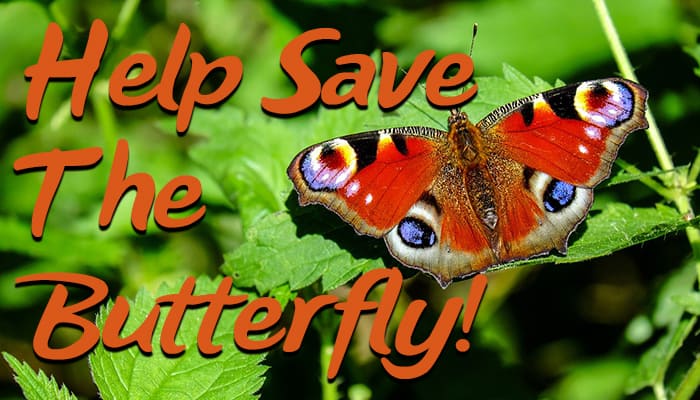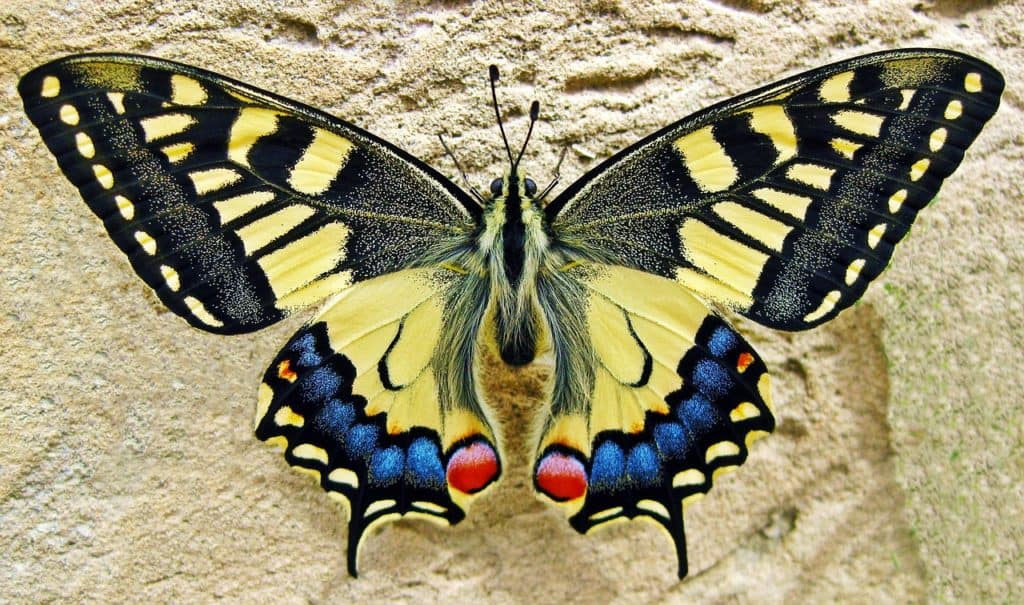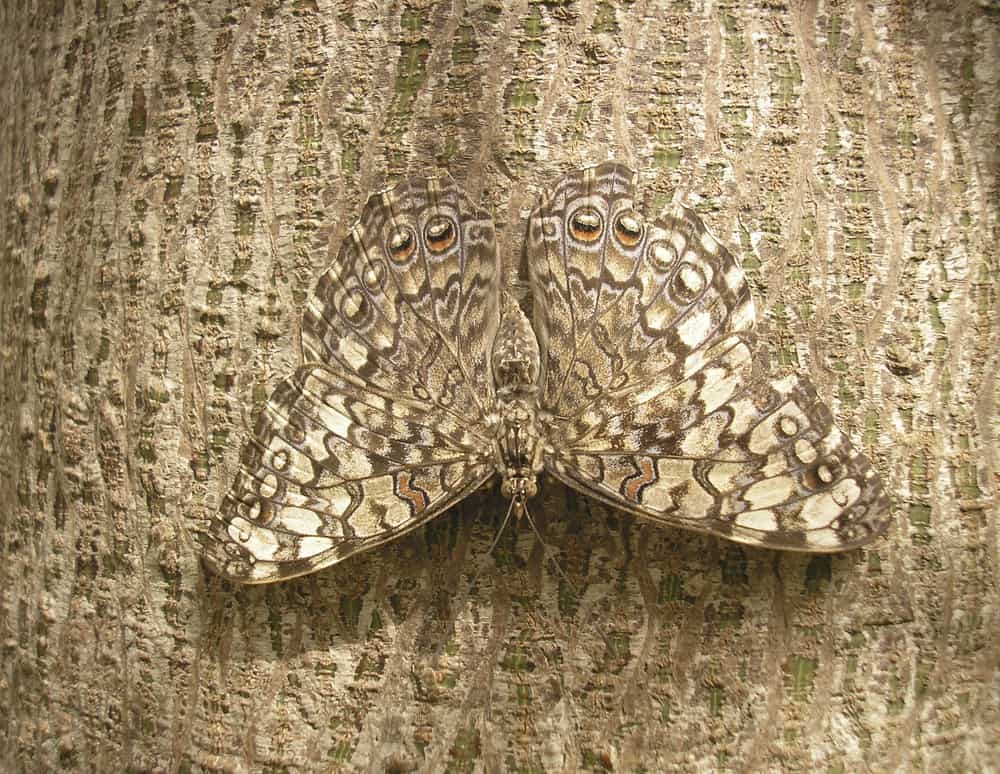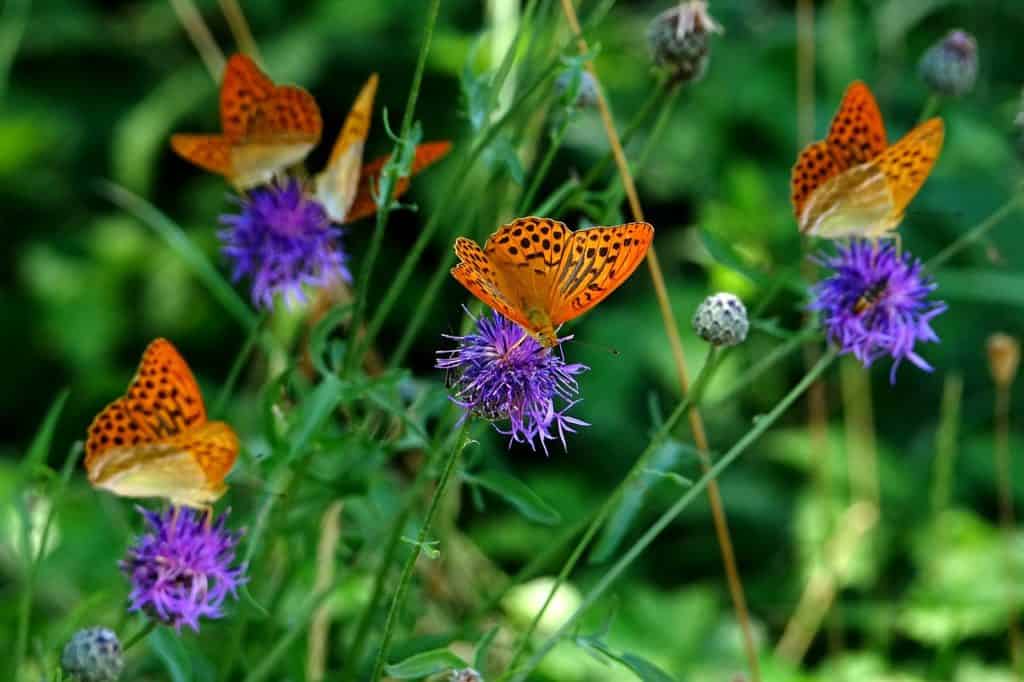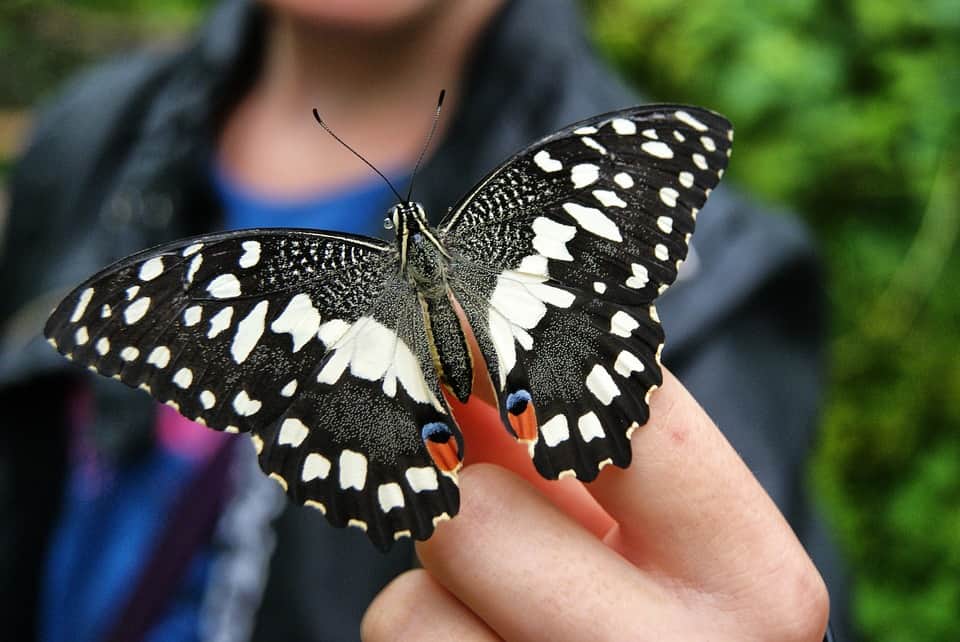The Ultimate Guide to Butterflies & How to Prevent Their Decline
ENVIRONMENT, ANIMAL RIGHTS - VEGETARIANISM, 5 Feb 2018
Clive Harris | DIY Garden! – TRANSCEND Media Service
15 Jan 2018 – Butterflies and moths have been around for millions of years. They used to be a common sight in gardens, but numbers have declined since the 1940s along with our other native wildlife species such as bees and hedgehogs.
It will come as no surprise to hear this loss is due to destruction of natural habitats such as wildflower meadows, peatbogs and ancient woodlands in favour of intensive farming practices, roads and housing developments that have stripped away the majority of their nesting and foods sites.
Climate change is partly responsible for butterfly decline too, producing wetter weather that alters the distribution of certain species.
The relentless march forward of ‘progress’ damages our 56 species of butterfly and 2,500 species of moths who are sensitive to change – but your garden can help them find food and shelter.
The Decline Of Butterflies
The State of the UK’s Butterflies Report shows ‘serious, long term and ongoing decline of UK butterflies’. It highlights how 76% of our butterfly species have declined over the past forty years, with species such as the High Brown Fritillary at risk of extinction, and the once common Small Tortoiseshell becoming a rare sight.
The new State of Britain’s Larger Moths 2013 report mirrored this decline, which is hardly surprising since many moths are daytime creatures and others are what you could describe as night butterflies. Records show moths have declined 28% over the same period.
But why should we care about pretty, fanciful butterflies?
Because it’s bad news for the food chain. Animals rely on butterflies for food, including us. Butterflies and moths are pollinators and without them our crops are in trouble.
Some butterflies have declined so severely they’re protected under law – the Large Blue, Large Copper and Swallowtail being just a few at real risk of extinction.
The decline is not only of concern to butterflies, its evidence of a problem in our environment. The face of our environment is changing, it’s turning into an urbanised monoculture reliant on pesticides, intensive farming and building to house and feed our ever increasing population – and this comes at the cost of our wild creatures.
Life Cycle of a Butterfly
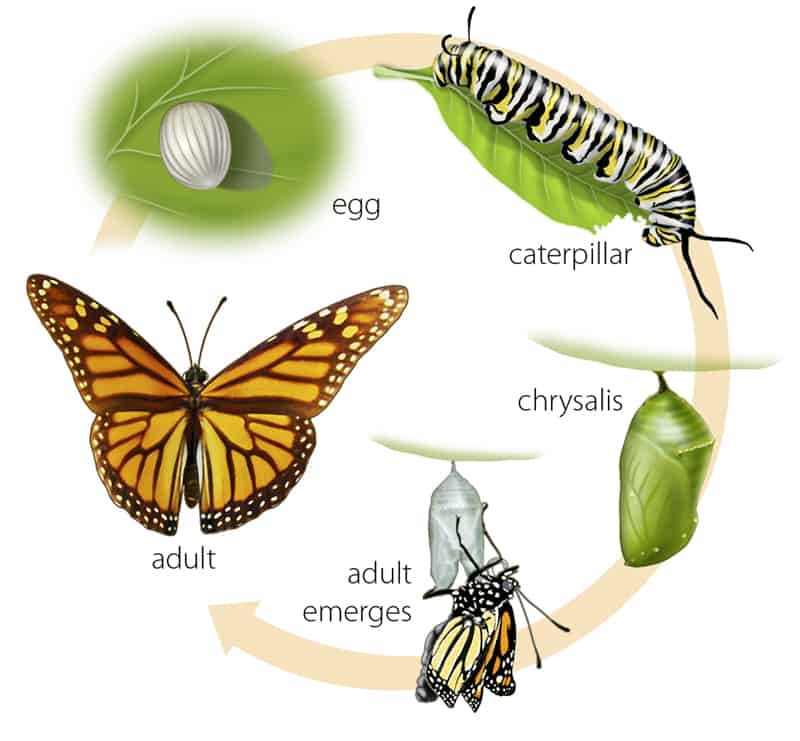 Image source
Image source
It’s worth remembering that butterflies have four stages of life and with that many stages it’s no wonder environmental changes wreak havoc on their life-cycles.
We all learn about the caterpillar to butterfly in primary school, but it’s easy to forget that wriggling grub emerging from a tiny egg to eat your hard grown vegetables will turn into a beautiful pollinating insect. Talk about ugly duckling syndrome! Of course, they will be a chrysalis for a time too.
Butterflies don’t live that long, the lifespan depending on their species and the weather. Larger butterflies like the Peacock can live a season with hibernation, but other smaller ones only manage a few weeks to a few months.
The Anatomy of a Butterfly
A butterfly or moths wings are the most dramatic part of their anatomy, but there are other parts too.
They have six jointed legs beneath a head, thorax which is the chest, and an abdomen – the tail. A butterfly’s head has large compound eyes that allow it to check all around for predators. It will also have two antennae.
Antennae assess the surrounding environment and report back on chemical activity – a bit like a snake’s tongue. They use them to detect nectar producing plants and to track the pheromones of a mate. Near the antennae is a special organ used for flight orientation and balance. It’s called the Johnston’s organ. Butterflies with a damaged Johnston’s organ may fly in circles and be unable to manage a straight line.
Their wings are made from scales, but not like fish scales, they are made from thin material called chitin which is stretched over vein type structures. There are four wings in all. The wings closest to its head are usually triangular in form, and the lower pair of wings is fan shaped. The wings provide insulation, allowing the butterfly to heat up, and they’re often brightly coloured to scare away predators.
Since a butterfly can’t live without heat, the wings are a very important method of retaining and building up body heat. They don’t regenerate, which is why butterflies seek shelter in winds and rain.
Where do Butterflies Live?
This depends on the species and where they are on the point of the butterfly lifecycle.
Species prefer different locations for shelter and egg laying, which is one of the reasons why they are declining. Certain habitats like wildflower meadows are hard to come by – we’ve lost 97% of wildflower meadows over the past few decades.
Nettles are preferred by Small Tortoiseshell butterflies that lay their eggs on stingers, whereas Large Whites prefer your cabbages, and Brimstone butterflies lay their eggs on buckthorn.
A caterpillar and chrysalis won’t go far from the food source, but an adult butterfly will spend its life on the wing searching for nectar and egg laying sites.
At night they creep into small crevices, in hedgerows and masonry or anywhere that affords them protection. Moths do the same –there are many species of daytime moth flitting around with the butterflies too.
A butterfly house provides welcome shelter. Place your hotel in a south facing sunny location because butterflies like warmth – their wings are adapted to soak up as much heat as possible. Ensure it remains dry inside by attaching a porch if yours doesn’t have this vital addition. Fix it to fence post or brick wall to avoid a tunnel of freezing wind. A butterfly house stood on away from a wall or on a chain is little use.
Peacock butterflies and Tortoiseshells may hibernate in your butterfly house so don’t take the winter months as an opportunity to clean it out.
httpv://www.youtube.com/watch?v=hggby_4gNqY
What Do Butterflies Eat?
Butterflies survive on nectar. They taste it through sensors on their feet, and drink it from the flower centre using a proboscis – a long, narrow tube just like a straw. If you stand quietly to watch a butterfly at a flower you will see this fascinating body part in action. Other sources of food depend entirely on the species but fruit, tree sap and the sodium found in our sweat are attractive to some.
Caterpillars eat plants, and plenty of them, each specific to their species. In fact, the children’s story The Very Hungry Caterpillar could be considered a factual book! So much energy is needed to transform into a butterfly that caterpillars are mini eating machines.
Peacock caterpillars eat and live on nettles as do Comma and Red Admiral caterpillars whereas Elephant Hawk moth caterpillars dine on willowherb and fuchsia, and the Holly Blue is specific to, you’ve guessed it, holly. Other caterpillars love trees such as alder buckthorn, others like wild roses, lavender – in fact most native flowers and weeds are utilised by our caterpillars.
In case you were wondering, only two out of the 2500 species of moth will eat your clothes, and they only enter the house because they are attracted to light, not because they want to dine on your expensive winter wool coat!
Do Butterflies Have Any Predators?
Unfortunately for butterflies they have a range of predators at their caterpillar, pupa and adult stage. Birds, spiders, frogs, toads, hedgehogs, bats, cats, dogs, wasps all eat caterpillars, butterflies and moths. Butterflies are especially vulnerable when they emerge from the chrysalis to pump liquid into their wings and wait patiently for them to harden before flying away.
To defend themselves an array of defences have developed. Caterpillars blend into the foliage, others stand out a bright shade of danger, and some have spines. Butterflies often have bright markings that mimic something dangerous – for example the Peacock butterfly has two large spots that resemble eyes on his wings to scare predators, but at rest the wings are closed up to reveal a dull, camouflaged grey. When folded a butterfly is so thin it’s difficult to spot from above.
Some caterpillars and butterflies release a chemical scent to deter predators and other have foul smelling parts such as the Swallowtail.
Do Butterflies Hibernate?
Some of the larger UK butterflies hibernate as eggs, as caterpillars, a chrysalis, or as fully fledged adults.
Our annual visitors such as the Painted Lady can’t stand winter temperatures and fly to back to warmer African climates. Most Painted Ladies retuning to Africa in autumn are fresh, following in their parents’ footsteps with no directions or guidance. The fact they can do this at an altitude of 500 metres makes the Painted Lady an astonishing creature.
Those hibernating do so in the coldest winter months because there are no food sources available. Brimstone, Small Tortoiseshell, Red admiral and Peacocks will all hibernate, potentially in your butterfly hotel, in dried-out grass stalks, in brickwork, or in your house.
Don’t disturb a hibernating butterfly, they do not harm, and releasing one that’s woken in the central heating means death if it’s cold outside. Instead, put it in a shoebox with a thin cut on one side. Then place it in a cold, dark place like your garage or shed to continue hibernating.
The slot is vital – don’t forget to cut the box so a waking butterfly can escape on its own. If it’s warm and sunny outside put the box into a hot spot, and the butterfly will fly away – if it made it through hibernation safely. Many don’t make it, either running out of stored energy or falling ill to fungal infections in damp hibernation spots.
How Butterflies Help the Garden
Butterflies and moths are not only beautiful garden ornaments, they are vital pollinators.
Whereas bees get covered in pollen butterflies take a smaller amount on their slender legs, but they travel greater distances than bees, flitting around like nomads instead of returning to a hive or burrow. This means they spread pollen over a larger area strengthening the genetic variation of DNA in plants. This means our plants are tougher and less likely to fall prey to disease.
Butterflies and moths also provide food for our birds. Blue tit chicks in particular feast on caterpillars in spring, and the adult butterflies are a filling meal for both birds and bats. In fact without butterflies our native wildlife would go hungry as mating and breeding seasons are arranged around food sources.
You can help in a number of ways:
Intensive farming practices find farmers more often growing tall grass for silage instead of the traditional wildflowers for hay, so butterflies have a hard time finding food.
Bees and butterflies need flowers to survive and in turn birds, bats and other mammals need bees and butterflies. But it’s not as simple as loading up your boot at the garden centre because caterpillars need certain plants to thrive – here are some good choices:
- Nettles
- Bird’s-Foot Trefoil
- Nasturtium
- Garlic Mustard
- Ladies Smock
- Long Coarse Grasses
- Oak
- Elm
- Holly
- Ivy
You might not be keen on common nettles, but a patch in a sunny garden corner is invaluable. Limit their spread by growing nettles in a sunken container.
Adult butterflies and moths need nectar – Most native wildflowers and weeds are appreciated by our pollinators, but here are some good choices:
- Aubrietia
- Bluebell
- Clover
- Cuckooflower
- Daisy
- Dandelion
- Forget-Me-Not
- Pansy
- Primrose
- Wallflower
- Oregano
- Buddleia
- Lilac
- Sedum
- Michaelmas Daisy
- Asters
- French Marigold
- Nnapweed
- Lavender
- Marjoram
- Red Valerian
- Scabious
- Thyme
- Verbena
- Flowering Ivy
Try to have as many suitable flowering plants as possible right through the seasons. Choose warm, sunny spots to plant your nectar-rich flowers and keep deadheading them so more blooms appear. This is especially important in spring and autumn when food sources are slim pickings.
Its good practice to buy genuine UK plants and wildflower seeds because exotic species are not always suitable food for butterflies.
What Else You Can Do to Help Butterflies
Don’t collect them. This is an old fashioned hobby, but some people still catch butterflies in nets and pin them to boards. It’s a cruel practice and some butterflies are protected so you could get into trouble. Use a camera instead.
Join your local environmental group to learn about coppicing and natural techniques that enhance the environment. Environmental groups plant wildflowers and count the butterflies to give picture of their health.
Stop using pesticides. Pesticides kill everything they land on and sprays are carried around on the wind. This means butterflies, moths, caterpillars, eggs and pupa are destroyed. Bees, ladybirds, hoverflies and all pollinating insects are wiped out. A sterile garden is a wildlife free garden.
It won’t take long for natural aphid predators to arrive if you simply spray with citrus soaked water or remove them by hand. Just wear gloves it’s not that bad. Gardeners have managed for thousands of years without pesticides, so net your cabbages – don’t spray them.
As well as growing more nectar rich flowers, keep an area of garden wild. Leave it unmown, add bee and butterfly hotels, some native wildflower seeds, a hedgehog box, some logs, and the wildlife will move in. If you don’t have a garden, a hanging basket or container of flowers on a balcony will also attract bees and butterflies. Any little you can do will save lives and promote a healthy environment.
Water all around – but not a drop for our wildlife to drink. We have taps, but mammals, birds and insects don’t. In hot summer months wildlife dies from dehydration. A simple bowl of fresh water is so easy, yet saves countless lives. Butterflies drink water too and the best way to help is to fill a dish with marbles or pebbles and fill it daily. Bees and butterflies will sit safely in the pebbles with danger of falling in.
Save a Butterfly
If you find a butterfly on a cold, wet day it’s probably in trouble. If it’s in water then it will certainly drown because once cold they need sun to get moving again. Get involved and save that butterfly!
Remove it from the cold or watery situation into a sunny, sheltered area away from predators. If you are feeling generous a teaspoon of cool water with a bit of dissolved sugar will give the butterfly enough energy to find safety. Ensure you don’t get any of the solution on its wings as it will be unable to fly away and simply die. When it takes a drink you’ll see that fabulous proboscis emerge. It’s a sight worth waiting for, so be patient.
How to Pick Up a Butterfly
Butterflies do not bite, sting or harm you in any way. Don’t leave a butterfly to die if you can help. If possible use a glass with a piece of card slipped beneath, but if this isn’t possible encouraging the butterfly onto your finger or a leaf is best all round.
If it’s in water, or won’t budge, you can gently pick it up. Cupped in your hands is a good method, and you can pick it up by the wings if you don’t rub them together. In order to escape from predators butterflies can fly with over 70% of their wings missing, despite us being told as children they die if you touch the delicate wings. Be gentle and slow at all times.
Always pop a watery butterfly, bee, moth, hoverfly, or ladybird somewhere sunny to dry out, away from winds and birds or bored cats.
Bye Bye Butterfly
The loss of our iconic butterflies is more than a shame, it’s an indication we are changing our environment with building, intensive farming practices, urbanisation and a shocking lack of knowledge or conscience.
Losing our biodiversity impacts us in ways we may not consider or yet understand. Our crop harvest is mainly pollinated by bees and butterflies. Insect loss has an effect on birds and mammals too.
The degradation of our world by activities to solely benefit the human race is one of the biggest issues facing us today.
We must remember the planet belongs to all of us and when we change fundamental principles that have evolved over millennia we play god in a field we know little about.
Individuals like us can take steps to help re-flower our green spaces, avoid chemical insecticides and learn about our environment. These steps are essential and they need to quicken pace, because our native wildlife is running out of time and a world without flora and fauna would a difficult one.
______________________________________
 Clive Harris – Gardener, blogger, outdoor enthusiast, husband, dad, and all the rest!
Clive Harris – Gardener, blogger, outdoor enthusiast, husband, dad, and all the rest!
Go to Original – diygarden.co.uk
DISCLAIMER: The statements, views and opinions expressed in pieces republished here are solely those of the authors and do not necessarily represent those of TMS. In accordance with title 17 U.S.C. section 107, this material is distributed without profit to those who have expressed a prior interest in receiving the included information for research and educational purposes. TMS has no affiliation whatsoever with the originator of this article nor is TMS endorsed or sponsored by the originator. “GO TO ORIGINAL” links are provided as a convenience to our readers and allow for verification of authenticity. However, as originating pages are often updated by their originating host sites, the versions posted may not match the versions our readers view when clicking the “GO TO ORIGINAL” links. This site contains copyrighted material the use of which has not always been specifically authorized by the copyright owner. We are making such material available in our efforts to advance understanding of environmental, political, human rights, economic, democracy, scientific, and social justice issues, etc. We believe this constitutes a ‘fair use’ of any such copyrighted material as provided for in section 107 of the US Copyright Law. In accordance with Title 17 U.S.C. Section 107, the material on this site is distributed without profit to those who have expressed a prior interest in receiving the included information for research and educational purposes. For more information go to: http://www.law.cornell.edu/uscode/17/107.shtml. If you wish to use copyrighted material from this site for purposes of your own that go beyond ‘fair use’, you must obtain permission from the copyright owner.
Read more
Click here to go to the current weekly digest or pick another article:
ENVIRONMENT:
- COP30’s Three F-Words: Failure on Fossil Fuels
- Declaration of the Peoples’ Summit Towards COP30
- Plutonium Found at Former San Francisco Naval Shipyard – Navy Faces Cover-Up Claims
ANIMAL RIGHTS - VEGETARIANISM:
